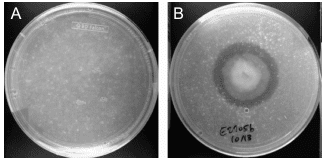
Example of PUR-A plates initially used to screen for polyurethane degrading activity after 2 weeks of fungal growth. (c) Department of Molecular Biophysics and Biochemistry, Yale University
A group of students from Yale University, along with molecular biochemistry professor Scott Strobel, were on a routine trip to the Amazon’s Yasuni National Park, one of the most biodiverse regions in the world, when they stumbled across a peculiar type of mushroom capable of eating polyurethane plastics. If successfully applied to landfills clogged with millions of metric tons of garbage plastics, this could have a potentially critical role in cleansing the environment.
Polyurethane is a synthetic polymer which is makes up most of today’s plastics. Although, plastic is recyclable in certain degree, most of the world’s plastic wastes are simply dumped in giant landfills where it simply remains there indefinitely, since it’s not biodegradable.
Pestalotiopsis microspora was showed to to have the most ability to survive while consuming and degrading polyurethane in aerobic and anaerobic (oxygen-free) environments, like those found in waste landfills. Initially the scientists collected 59 fungi endophytic organism, and after a lab analysis they selected Pestalotiopsis microspora as the most effective fungus , by observing the rate of plastic degradation.
“Polyurethane seemed like it couldn’t interact with the earth’s normal processes of breaking down and recycling material. That’s just because it hadn’t met the right mushroom yet,” the authors write in the paper.
Yes! This remarkable fungus can survive dieting exclusively on Polyurethane, without any kind of oxygen. It’s been proven to work extremely well under lab conditions, however, it’s yet to been tested on massive landfills, but there doesn’t seem to be any indication that it should work. The same paper notes more and more plastic is being produced every year and cites 2006′s production at 245 million tons. How much of these plastics will end up in the Earth’s soil? Super-fungus to the rescue!
Let’s not forget about the Chernobyl fungus that feeds on radiation either. I for one welcome our new mushroom overlords.
The research was published in the journal Applied Environmental Microbiology.









